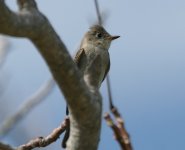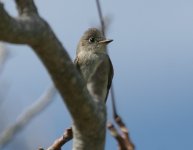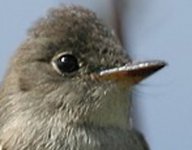-
Welcome to BirdForum, the internet's largest birding community with thousands of members from all over the world. The forums are dedicated to wild birds, birding, binoculars and equipment and all that goes with it.
Please register for an account to take part in the discussions in the forum, post your pictures in the gallery and more.
You are using an out of date browser. It may not display this or other websites correctly.
You should upgrade or use an alternative browser.
You should upgrade or use an alternative browser.
Flycatcher/Phoebe? (1 Viewer)
- Thread starter searobin
- Start date
More options
Who Replied?I'm sure it's not Eastern Phoebe which, as you say, would look darker headed. The eye-ring looks very weak and the lores concolorous with the rest of the head, so I'm thinking it's not an empidonax; also it looks a bit too attentuated for one of those. I think you could well be right with Eastern Wood-Pewee. Have you got any more pics of it?
Jane Turner
Well-known member
I ran a mile from this! Little things like how long are the wings? And does it have wing bar? would help!
It's a Wood Pewee alright, look at the length of the bit of wingtip visible. But, I wouldn't take it any further than that. Sure, the odds are overwhelming based on location that it is Eastern. But that lower mandible is mostly dark, and that is a Western feature. Jane really didn't need to run, as in addition to the wing tip we can also see the tip of at least one of the median wing coverts, i.e. the edge of the upper wing bar. Now, the intriguing part is that it appears distinctly and brightly buffy -- which would be good for juvenile Eastern Wood Pewee, but then the mostly dark lower mandible becomes even more problematic.
Call it an interesting Wood Pewee.
Call it an interesting Wood Pewee.
Bluetail said:Have you got any more pics of it?
Nothing that would give us more to think about:-(
Attachments
Where is the information about the bill coloration? Sibley's doesn't identify this as a distinguishing feature between the Eastern and Western but shows the wing bars as an identifier in juveniles but I'm not sure we can see them well enough in the picture to use the Sibley's description.
Katy Penland
Well-known member
Actually, Sibley says this about Eastern and Western (pg. 323 of the "big book"): "Wing-bar patterns noted above may be the best way to distinguish these two species visually, but these characteristics overlap and are variable with age and wear. Western averages darker overall, evident in complete grayish breastband, darker centers of undertail coverts, less greenish color on back, and mostly dark lower mandible." As Thayeri said, this bird's lower mandible is mostly dark. But from the photos, I can't tell whether this is a dusky "vest" or "breastband."
Oh joy, another genus of flycatcher I can't ID except by voice.

Oh joy, another genus of flycatcher I can't ID except by voice.
atricapillus
Well-known member
___________________________________affe22 said:Guess I didn't look low enough on the page. If it was a Western, would that be a first record for New Jersey?
Hatch-year Eastern Wood-pewees have a lot of dark in the bill. Westerns tend to look pretty uniform. Also, there is a little smidgeon of the wing-bar visible that appears buffy yellow rather than whitish. Maybe weak evidence, but the influence is towards Eastern Wood Pewee.
CHEERS, JOE G
Motmot
Eduardo Amengual
The lower mandible stood out to me, looking quite dark, with that dark extending too far back along the mandible, compared to the Eastern Wood-Pewees I have been seeing in recent months (adult and juvenile). So I looked it up in Sibley, and found that he not only considered color of the lower mandible to be potentially important in distinguishing between the two species, but he illustrates the juvenile EWP with an even lighter lower mandible than the adult. I don't mind silent IDs where location is a big factor, but I want the bird to be a model for their species, and if there are marginal or contradictory features, then I consider that significant and worth mentioning. Hence the post.
I just checked another couple of field guides, and National Geographic and McGraw-Hill also consider the amount of dark on the lower mandible to be important -- but make clear that is for adult Pewees, and that juvenile Eastern Wood-Pewees may have an all dark bill. As Joe G. says, and that is good to know (but not all do, I have certainly seen Wood-Pewees with buffy wing bars and all light lower mandibles).
So, adding it all up, lower mandible color is an important indicator for distinguishing between the species (though it is not diagnostic), but the darker lower mandible is fine for EWP IF the wing bars are buffy (meaning the bird is juvenile), which they are, so I feel a lot better about saying Eastern Wood-Pewee rather than just Wood-Pewee -- thanks, Joe G.!
I just checked another couple of field guides, and National Geographic and McGraw-Hill also consider the amount of dark on the lower mandible to be important -- but make clear that is for adult Pewees, and that juvenile Eastern Wood-Pewees may have an all dark bill. As Joe G. says, and that is good to know (but not all do, I have certainly seen Wood-Pewees with buffy wing bars and all light lower mandibles).
So, adding it all up, lower mandible color is an important indicator for distinguishing between the species (though it is not diagnostic), but the darker lower mandible is fine for EWP IF the wing bars are buffy (meaning the bird is juvenile), which they are, so I feel a lot better about saying Eastern Wood-Pewee rather than just Wood-Pewee -- thanks, Joe G.!
From Kenn Kaufman's Advanced Birding: "In either species the lower mandible may be almost all dark or almost all pale; but typically it is nearly all dull pale yellow in Easterns (with a small dusky area at the tip), while in Westerns the dusky area usually covers at least the dtstal half of the lower mandible."
Users who are viewing this thread
Total: 2 (members: 0, guests: 2)








